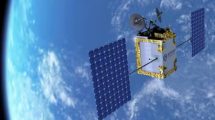
Khaled bin Ahmed Balkheyour, president and CEO of Arabsat, outlines to SatellitePro ME, a leadership position for three decades that has been a fascinating combination of innovation, partnership with broadcasters through tough times and knowing the myriad preferences of audiences in more than 100 countries across the MENA region and Europe.
Congratulations on launching the Mauritania bouquet where Arabsat will be constructing the digital broadcasting platform in Nouakchott. Is this a typical initiative on the part of Arabsat?
The Mauritania bouquet is part of a strategic initiative established by Arabsat in its marketing plan in 2009 – the MAPs strategy ‘Media Access Points’ strategy that emphasises the establishment of direct uplink facilities in Arabic countries with a large number of TV channels, an initiative that is increasingly relevant given the liberation of media and [easing up on] regulation in some countries. The objective is to cut the additional costs associated with satellite transmission and direct broadcasters’ budgets towards content development. The MAPs strategy resulted in the launching of new bouquets and channels across Bahrain, Jordan, Qatar, Morocco and Sudan. The Mauritania bouquet will be ready hopefully by the middle of this year.
You offered the Saudi premier league to Arab expatriates in Europe. What has the response been and how challenging has your campaign been to expand your foot-print?
In September 2011, Arabsat, in cooperation with Saudi TV, launched 12 channels to support the broadcasting of Saudi sporting events and especially the Saudi football league that is being broadcast exclusively on Arabsat across the MENA region. A total of six HD and six SD channels were launched. Arabsat Badr-4 has always been the Arabsat video distribution hotspot for Arab communities in Europe. We have received incredible feedback for our initiative. Some Arab broadcasters are considering dropping their channels from European providers to migrate to BAdr-4. It provides a safe environment for the Arabic broadcasters in comparison to the current, polluted neighborhood on European satellite operators, in terms of proliferation of porn and gambling channels that do not conform with our culture.
How significant is the challenge from the growing terrestrial/fibre networks across the MENA region? Also now that other HD satellite operators are coming into play, how does that affect Arabsat?
Indeed across the MENA region, connectivity through fibre, especially backbone connectivity for voice and data through transatlantic cables is growing rapidly and many international termination stations have been established. This carries a significant part of the telecom traffic. However, the delivery of such traffic to the termination stations remains a problem. Besides the Gulf countries, the rest of the MENA still suffers from under development in terms of fibre connectivity and satellite still plays a significant role in those countries.
Arabsat started its HD initiative back in 2007. Currently, Arabsat has over 35 HD channels and is expecting another five to 10 channels this year. Around 90% of FTA HD channels are available only on Arabsat at its hotspot at 26deg E, a hotspot that has grown to hold over 450 TV channels, 200 programmes and three pay TV networks. In addition, Arabsat has established two HD platforms, one in Amman and one in Madrid.
The problem in the MENA with HD remains at the production side. Broadcasters are still hesitant to engage in the upgrade of production infrastructure, thus limiting the number of genuine HD content hours . The satellite operator’s role is to make the entry cost for HD broadcasters as minimum as possible so that they can focus on content.
Most of the HD content is still sports-centric, particularly with pay TV channels. This is why the Arabsat initiative for free-to-air HD channels becomes very important.
With its 5th generation satellite, Arabsat has become the largest provider of HD capacity in the region and will continue to be able to support broadcasters with the right incentives for them to invest in HD. Last year during CABSAT-MENASAT in Dubai, Arabsat launched the first 3D live channel and visitors enjoyed the 3D experience at the Arabsat stand.
Arabsat prides itself on ensuring backup capacities that guarantee service continuation in emergency situations. Could you shed light on these backup capacities?
The current circumstances in our region amply justify the high degree of attention Arabsat pays to maintaining backup capabilities. As you know, broadcasters like Jazeera and Arabiya are now suffering and have been suffering since early 2011 from intentional jamming associated with the current political situation in the Middle East. Arabsat has deployed many satellite transponders, bouquets and channels for both broadcasters to survive the jamming and still be able to deliver content to their viewers.
Arabsat Badr-5 constitutes hot backup for both Badr-4 and Badr-6. In case a failure took place on any of the bouquets on either one of them, Badr-5 will take up the bouquet with the same frequency and viewers will never notice the transition.
Of course, interference is still there. The political situation is still unsettled. We have interacted with regulatory bodies including the International Telecommunication Union (ITU) in terms of documenting and identifying the intentional jamming incidents.
Arabsat has its own geo-location facilities operated by its operation center in Riyadh and that helps Arabsat to identify and document sources of interference to the closest proximity possible.
Other than deliberate interference, how challenging is the general satellite interference problem for your operations and what measures are you taking to tackle the issue?
Indeed, interference continue to be a challenge for all satellite operators, especially with the proliferation of many VSAT networks and a space that is growing in congestion. To resolve the issue, our initiatives at Arabsat are based on:
1- Educating our VSAT partners , SNGs and telecom network users with satellite access about our strict access policies.
2- Conducting professional training programmes for our customers and partners.
3- Establishing a certificate programme in association with the Global VSAT Forum (GVF), to deliver this certificate to all of our users.
4- Participating as an active member of relevant industry bodies such as the Satellite Interference Reduction Group (sIRG).
At CABSAT-MENASAT this year, Arabsat will host the Carrier ID convention as part of our commitment to address and solve the issue of interference.
As an operator in the region for the past 30 years, you have had a lot of experience dealing with broadcasters in the region. What do you believe drives a successful partnership between a satellite operator and a broadcaster?
Broadcasters, especially national and large private broadcasters, appreciate a partnership relationship rather than a customer-provider equation. They expect you to be there for them in the hard times and to support them when they have large projects that may require re-location of considerable resources. Arabsat has excelled in nurturing such relationships due to an internal structure that allows for dynamic decision making and flexibility. One success story that is a testimony to our approach is the launch of the 12 Saudi Sports channels. Arabsat mobilised all its satellites, platforms and network resources to support the launch of the channels by the start date of the Saudi league. We launched a media campaign that is unprecedented in scale for a satellite operator in the region. The media campaign included advertisements in 12 news papers, eight TV channels, seven radio channels, 80 online venues and more, to announce the launch of the channels.
The business model for broadcasters is getting increasingly fragile in a region that has a plethora of channels. For broadcasters, satellite capacity accounts for a significant chunk of their expenditure. What are your views on this issue?
This could be the case for small and medium-sized broadcasters. To cater to them, we established the MAPs strategy that I mentioned earlier, to support broadcasters and cut costs associated with satellite. Also, in addition, we have a wide network of media cities that have access to Arabsat satellites and this offers more options to the broadcaster.
Do you have any strategic plans to enhance your appeal or to retain customers through incentives and other services? What, in your view, makes you unique from other competitors in the market?
Our brand values are reliability, flexibility and availability; reliability relates to Arabsat’s quest to secure optimal performance from its satellites and associated platforms and infrastructure, and introducing new satellites and enhancing our backup capacities and platforms. Flexibility relates to the dynamic decision making process where we try to stay as far as possible from a large corporate, bureaucratic way of conducting business. And availability refers to both the physical availability of our satellites, as we have established long-term plans for satellite expansion, and to our account management activities where the customer and partner can reach any Arabsat official any time. Our partners and customers would say that the Arabsat attitude towards doing business is more like a family business – once you come on board- you become part of this family. Our slogan – Our World, Your World – expresses this spirit of service and sense of belonging.
While the broadcast sector reportedly accounts for 60 to 65% of your revenues, what plans do you have to grow revenues in other areas of communication including the internet and catering to other vertical markets including governments/military, oil and gas and so on?
Arabsat has established a good reputation across Africa in the telecom services. The 5th generation satellites’ programme which concluded in September last year incorporated the design and implementation of a full, pan Africa coverage associated with wide distribution and partners’ network. The applications were concentrated in backbone connectivity, GSM backhauling and business and government networks. This has created a new market for Arabsat that never existed before. A similar approach was followed with coverage over Central Asia. In our home market, the MENA, teleport services and backbone connectivity are available, given our distribution network and gateways in Europe, through cross-strapped coverage between Europe and the Middle East.
Last year, Arabsat started addressing vertical markets with the deployment of its first Ka-Band payload on-board its 5C satellite; an 8Gb payload that was contracted directly to the King Abdul Aziz City for Science and Technology to accommodate the needs of the Kingdom of Saudi Arabia for broadband, commercial, educational, government and military applications. Arabsat’s 6th generation satellite will incorporate more vertical business models based on the Ka-band payloads.
You now have an integrated fleet of 4th and 5th generation satellites that you financed mostly through internal resources. You continue to expand your fleet and area of operations. What is the current status and challenges going forward?
Arabsat is currently in the phase of designing its 6th generation satellite programme. The 6th generation programme will feature more coverage footprints , new technologies and services. Securing frequency bands and orbital slots continue to be the most challenging aspects of launching a satellite.
Our financial status is in excellent shape which gives us access to financing options available in addition to our earnings coming from our growing operations.
In 2004, although an inter governmental organisation (IGO), Arabsat initiated operations on a commercial basis. This was an essential step to sustain and grow our operations. Arabsat now has commercial operations through its regional offices in Dubai, Cairo and Paris, in addition to a wide network of media cities around the Arab World that sell Arabsat services directly. We also have an extensive network of agents, partners and teleport services.
Where do you foresee growth for satellite operators in the region and where, do you think you will invest further?
The 6th generation satellite will have a hosted payload on it and a very specific plan is being put into place now to accomplish this. Generally, satellite operators’ investments will focus on new technologies like Ka and HD and associated business models because this is the key for sustainability.














Add Comment